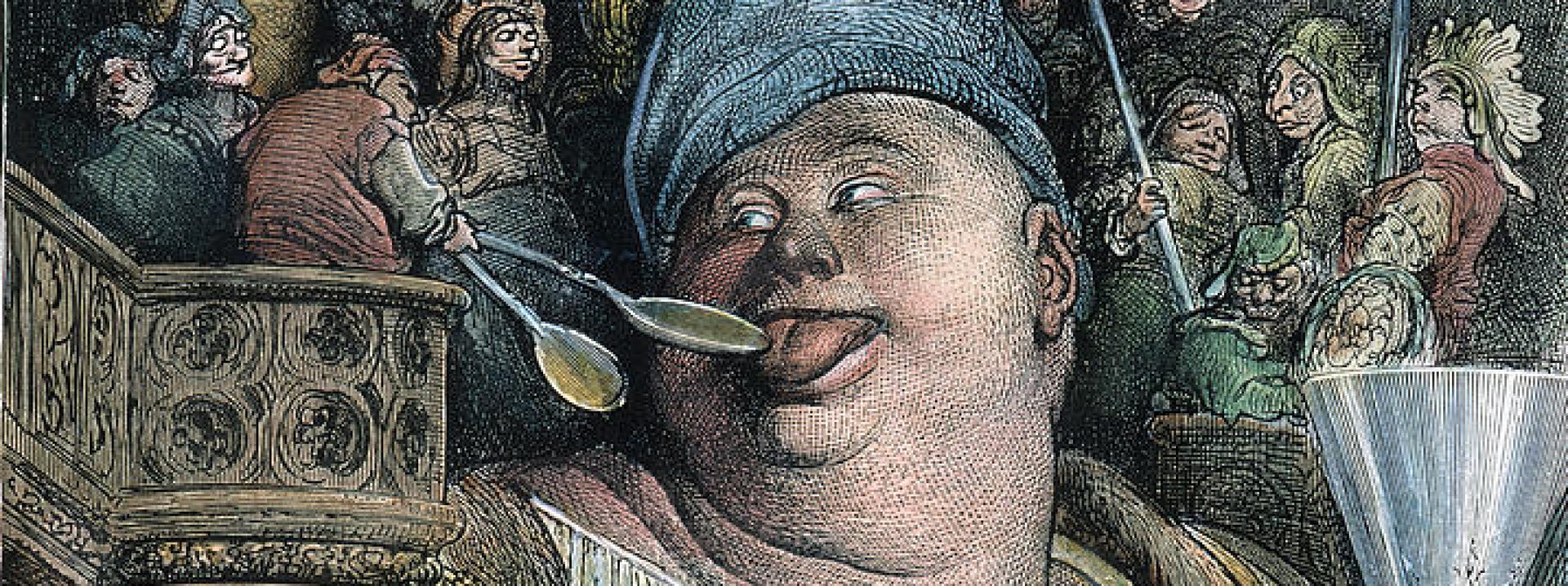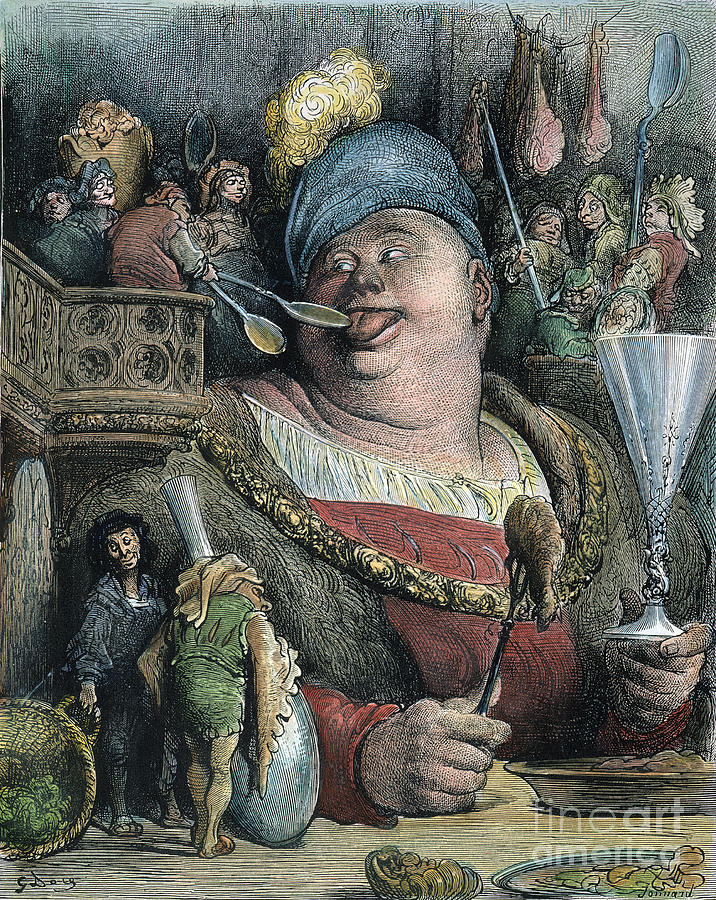Hi all! This post definitely isn’t perfect and to be honest I’m still struggling with Bakhtin and his views on violence in the Carnival, but here it is.
The longest and most connected surviving part of Petronius’ Satyrica is the feast at the house of Trimalchio. This feast has many aspects of the Carnivalesque, including feasting, laughter, folk stories and humor, and on the surface a reversal of hierarchies since the freedmen are so powerful and much smarter than our free born narrator Encolpius. However during this feast, the reader tends to feel uncomfortable as I think many of us did. Part of why is that Trimalcio’s feast, despite what may be happening on the surface, constantly reinforces hierarchies. One way it does this is through violence towards enslaved people who are owned by Triomalchio, and this violence goes directly against the ideas of the Carnivalesque.
In Rabelais and His World, Bakhtin does not imply violence is against the Carnivalesque, but actually talks about ways in which it works towards a Carnivalesque atmosphere. One example he gives takes place in Rabelais fourth book. In it, Pantegruel and his company travel to an island where the people make money by selling their bodies to be beaten. Friar John then picks a man and offers him 20 gold pieces and beats him very hard. The people worry the man has died, but when Friar John gives him the gold, he jumps up, “happy as a king.” Bahktin argues this is a Carnivalesque scene, saying the person being hit is a proxy for violence towards the king and therefore to the establishment. Bahktin does not mention that this violence is consented by all parts as an important part to contributing to the Carnivalesque. In fact, the other examples Bahktin gives do not have this feature. For example when the king Pircrochole is defeated by Gargatua and flees. His horse callapses and Pircrochole kills him out of anger. He then tries to steal a donkey, but the owner discovers him, beats him, and forces him into slavery. There is a clear reversal of hierarchy, but the consequences are real and lasting for Pircrochole. Still, Bahktin feels this is Carnivalesque, perhaps especially as Pircrochole is the enemy of our story.
We can see in both of these that the main element is the reversal of hierarchies, and that, at least according to Bahktin, this can preserve the Carnivalesque even when there is violence. But the Satyrica does not have this quality. One of the first events of the feast is the guests see a sign that says “No slave to go out of doors except by the master’s orders. penalty, one hundred stripes.” While this itself isn’t violent, it threatens violence to anyone who does not directly obey Trimalchio. Almost immediately after, a slave comes to the guests about to be flogged for having his clothes stolen. The slave begs the guests to help, and they implore the stewart to be merciful. The steward seems to not care much and spares the slave after a little complaining. While this may seem slightly like a reversal or at least festive since the slave is spared, it just shows that not only does Trimalchio have power over the slaves body, but also other men in the house and even, to a certain extent, the guests. This reprieve from violence only reinforces the control people have over the enslaved, and that people can beat slaves without much cause or thought.
The last scene I want to look at is when Trimalchio pretends the pig has not been gutted when in reality it was filled with sausages and other food. Trimalchio gets the cook to come out and asks why he has not gutted the pig. He then has him stripped and it seems he will either kill or beat the cook. The guests beg and Trimalchio instead orders the cook to gut the pig then and there. Then when the cook begins, all the food comes out. On its own, this scene has some Carnivalesque aspects that almost gives it a better feeling. The cook is importantly spared and, it turns out, was never actually in danger. The guests cheer and we even have a mock crowning as the cook is given a drink and silver crown. On its own, we may consider this Carnivalesque, but we have already been shown that the danger to the slaves is real and serious. During the scene we are genuinely fearful, as presumably are the guests, that the slave could be taken away and beaten or killed. Because of this, we feel more relieved rather than joyful or festive when the cook is spared, and Patronius quickly switches the subject so we are not able to marvel at the feast after our shock is gone.
It’s hard to say if violence ever has a place in the Carnival, but Bahktin clearly feels it does. Those who are hurt are typically the enemies in his examples, but are not always guilty of what the punishment would imply, as when Friar John brutally kills the people trying to steal from the monastery. And again Bahktin seems to have no problem that the violence causes lasting and real problems for the victims. This then leaves the hierarchies as the main and perhaps only reason the Satyrica can not fit into Bahktin’s model of Carnivalesque violence. The Satyrica shows how worthless the bodies of slaves were often believed to be, while Bahktin requires the worthless bodies to belong to kings or become kings. So even if we can accept some kind of violence in our Carnival, the violence in the Satyrica will still have no place.


I think that you make really great points about the tension of violence in regard to Bakhtin’s carnival. Admittedly, I’m also a little unsure of what to do with violence and carnival, but I think that your examples make it clear that there is an expectation in Bakhtin’s mind that violence should be enacted towards those who on a normal day would have power over other people. Trimalchio’s scene is really difficult because while Trimalchio himself is an ex-slave, he has become a man of status and therefore higher on the hierarchy than his slaves. Even though it was a common occurrence in Roman culture for ex-slaves to own slaves, the problem remains that Trimalchio boasts equality at his feasts, and therefore it supposed to be a carnival. Yet as you point out, the constant threat of violence towards the group that are already the lowest on the hierarchy is uncomfortable and very uncarnivalesque. Violence and the carnivalesque seem to attached by a very fine line!
This is a really insightful look into one of the aspects of the Carnivalesque that I– and I think a lot of others– have found the most troubling this semester. I think you’ve highlighted a really important distinction between the violence in the dinner at Trimalchio’s versus the violence that Bakhtin uses as examples of the Carnivalesque, in that the dinner at Trimalchio’s involves violence or threatened violence against those already at the bottom of the hierarchy. As Alice mentioned, Trimalchio’s status as an ex-slave may represent some form of inverted hierarchy in itself, but the violence that he threatens on others that he has power over seems to undermine what might otherwise have been Carnivalesque about this dynamic. I’m really glad you’ve decided to focus on this for your final because it’s definitely an important part of this topic to continue thinking about!
This addresses one of the major questions that we’ve had to grapple with this semester- is there room for hierarchy and violence in carnival? In the scene you mention with Friar John the depiction of beating someone is obviously violent, but welcomed in Bakhtins description of carnival. In your explanation of satyrica, that role reversal doesn’t exist, but violence exists. The scenes in satyrica might be considered “carnivalesque”, but it’s treatment of others and enforcement of hierarchy and violence excludes it from true carnivalesque nature. I still wonder how hierarchies, violence and power dynamics are allowed to exist and float through carnival?